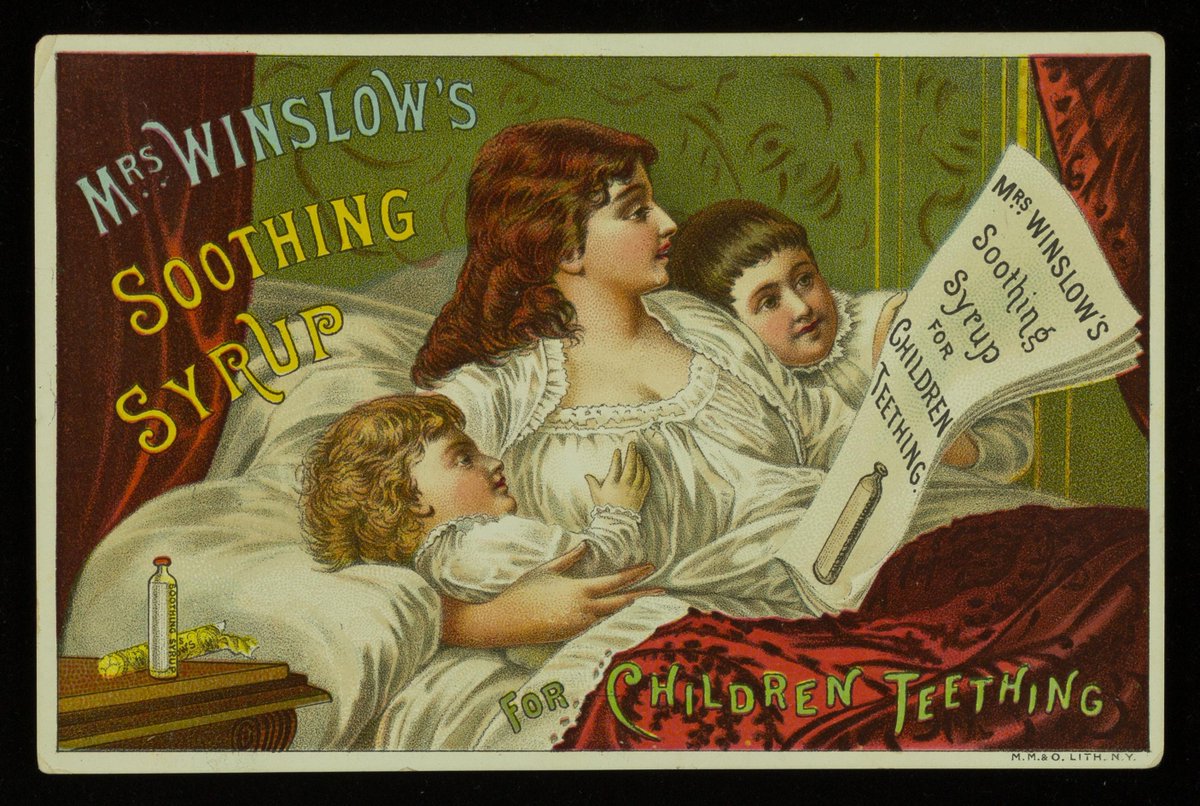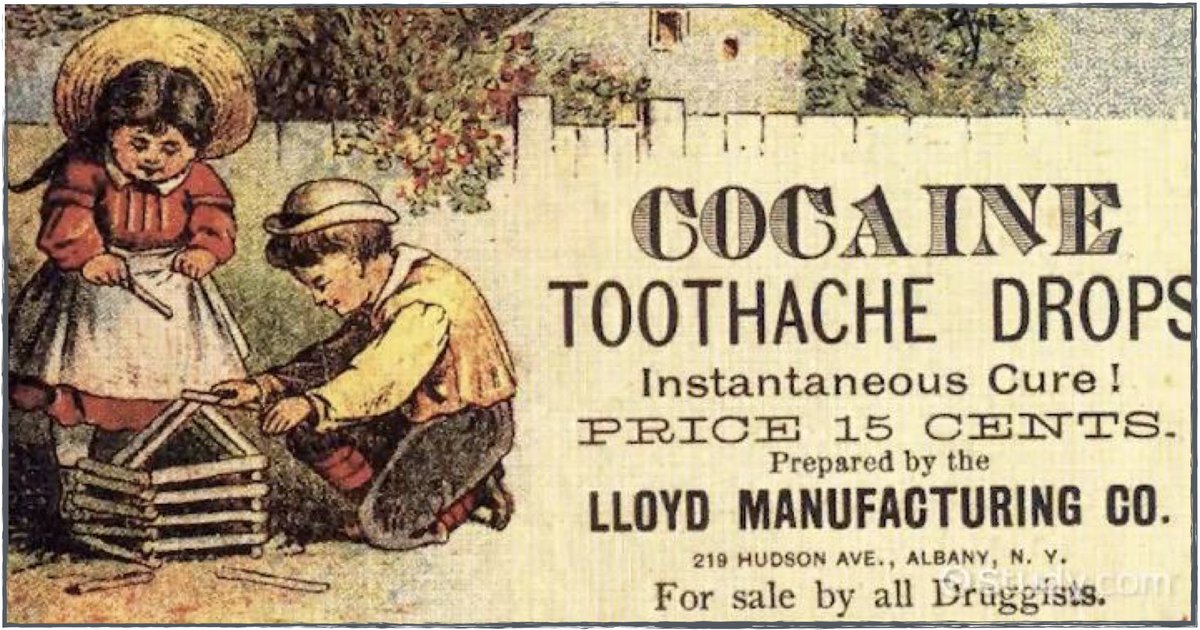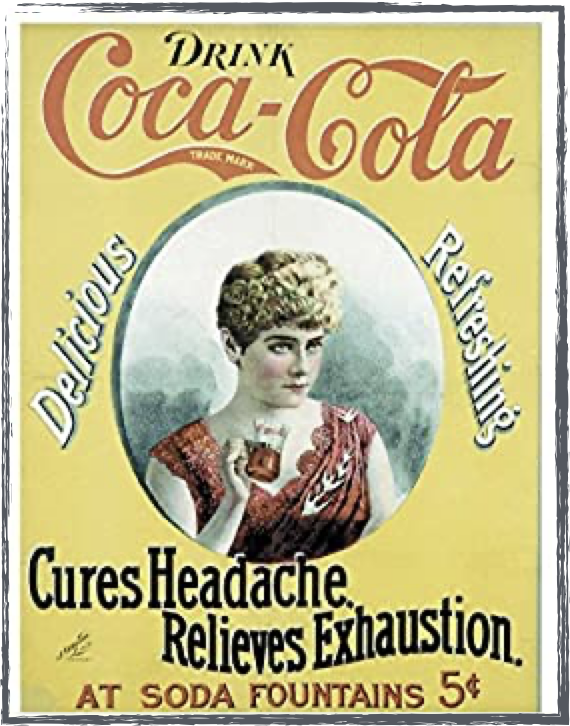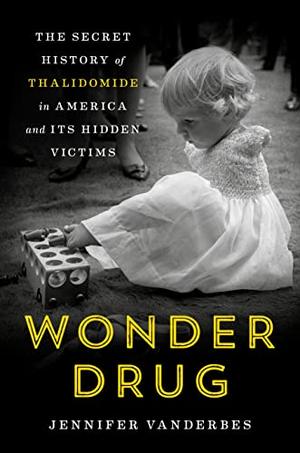How much do you know about food and drug safety?
Where did our current regulations come from?
And what were some of the greatest scandals that forced change?
We covered everything from swill milk, patent medicines, and thalidomide in our class today.
Here's what we covered 🧵
Where did our current regulations come from?
And what were some of the greatest scandals that forced change?
We covered everything from swill milk, patent medicines, and thalidomide in our class today.
Here's what we covered 🧵

We started with smill milk.
This was a massive problem that few—including in public health—have ever heard of.
In New York (and elsewhere) in the mid-19th century, milk was a big part of the daily diet, especially for children.
But people didn't realize how deadly it was.


This was a massive problem that few—including in public health—have ever heard of.
In New York (and elsewhere) in the mid-19th century, milk was a big part of the daily diet, especially for children.
But people didn't realize how deadly it was.


Usually marketed as 'pure milk' with depictions of happy cows and happy kids, the reality was WAY different.
A lot of milk—estimates are 60-80% of ALL milk at the time—was actually 'swill milk'.
Swill milk came from cows fed solely on a diet of distillery slop (aka 'swill').


A lot of milk—estimates are 60-80% of ALL milk at the time—was actually 'swill milk'.
Swill milk came from cows fed solely on a diet of distillery slop (aka 'swill').


You couldn't have had cows grazing in the middle of the city.
But people needed milk! And shipping it down on the train before refrigeration meant much of it would go bad quickly.
So distilleries and breweries found a solution—build sheds on site, and feed cows the spent grain
But people needed milk! And shipping it down on the train before refrigeration meant much of it would go bad quickly.
So distilleries and breweries found a solution—build sheds on site, and feed cows the spent grain

The milk produced was 'bluish' and thin. So chalk, flour, or Plaster of Paris was added to pass it off as potable.
This practice continued for a long time, despite recognition by many of what was happening.
The reason?
Swill milk makers were deep in the pockets of politicians.
This practice continued for a long time, despite recognition by many of what was happening.
The reason?
Swill milk makers were deep in the pockets of politicians.

But in 1858, Frank Leslie published an exposé.
His reports on swill milk exposed the horrible and unhealthy conditions of dairy cows in cramped sheds.
“A diet...of the swill made the cows sick, led to ulcerated sores all over their bodies, and caused their tails to fall off.”
His reports on swill milk exposed the horrible and unhealthy conditions of dairy cows in cramped sheds.
“A diet...of the swill made the cows sick, led to ulcerated sores all over their bodies, and caused their tails to fall off.”

A few weeks later, The New York Times wrote in outrage:
'If the Board of Health has any function, this certainly is one of them!'
And noted that 8,000 kids were dying a year from tainted, infected, and wholly unhealthy swill milk!
'If the Board of Health has any function, this certainly is one of them!'
And noted that 8,000 kids were dying a year from tainted, infected, and wholly unhealthy swill milk!

Legislation was passed in 1862 to end the production and sale of swill milk, but the problem lingered, in New York and many other places.
Eventually, Nathan Straus (co-owner of Macy's) set up pasteurized milk stations around the city. His much safer milk was cheap (or free!).
Eventually, Nathan Straus (co-owner of Macy's) set up pasteurized milk stations around the city. His much safer milk was cheap (or free!).

Swill milk wasn't the only health threat at the time.
Patent medicines were a HUGE business.
And contrary to their salubrious claims, many were making people very, very sick.
Unregulated, laced with dangerous chemicals, and available everywhere, patent medicines were a menace.
Patent medicines were a HUGE business.
And contrary to their salubrious claims, many were making people very, very sick.
Unregulated, laced with dangerous chemicals, and available everywhere, patent medicines were a menace.

These medicines usually weren't patented at all.
Their formulations were a 'secret', but many contained dangerous and addictive substances.
Like Dr. Seth Arnold's Cough Killer?
It was mostly morphine.
Which, strangely, CAN help a cough.
But also kills children.


Their formulations were a 'secret', but many contained dangerous and addictive substances.
Like Dr. Seth Arnold's Cough Killer?
It was mostly morphine.
Which, strangely, CAN help a cough.
But also kills children.


Mrs. Winslow's Soothing Syrup was a massive success in terms of sales.
It was marketed for teething, diarrhea, dysentery, and 'wind colic' in kids.
It was alcohol and morphine.
And many children died after taking it.
It was marketed for teething, diarrhea, dysentery, and 'wind colic' in kids.
It was alcohol and morphine.
And many children died after taking it.

For many patent medicines, the colorful packaging was matched by equally colorful claims.
In almanacs, trade cards, and newspapers, these patent medicines supported a massive advertising industry.
Ads for patent medicines claiming all kinds of cures were EVERYWHERE.


In almanacs, trade cards, and newspapers, these patent medicines supported a massive advertising industry.
Ads for patent medicines claiming all kinds of cures were EVERYWHERE.


This was also the time of the traveling medicine show.
Imagine huge events where fanciful claims were made by a huckster on a stage, all to get people to purchase whatever elixir they were hawking.
This was at a time when the medical establishment was relatively undeveloped.


Imagine huge events where fanciful claims were made by a huckster on a stage, all to get people to purchase whatever elixir they were hawking.
This was at a time when the medical establishment was relatively undeveloped.


Testimonials—often fabricated—attested to the power of each product.
Eventually many patent medicines started targeting specific groups, like women suffering from 'nervous prostration' or any of a growing host of pathologies.


Eventually many patent medicines started targeting specific groups, like women suffering from 'nervous prostration' or any of a growing host of pathologies.


Packaging was also informed by and fed on stereotypes.
As indigenous Americans were being pushed off their land onto reservations, images of Native Americans were gracing the packaging of more patent medicines, attesting to its 'natural' ingredients or purported 'purity'.



As indigenous Americans were being pushed off their land onto reservations, images of Native Americans were gracing the packaging of more patent medicines, attesting to its 'natural' ingredients or purported 'purity'.



Images of African Americans were often frequently used on patent medicines as well.
Sometimes to show 'folk wisdom'.
And sometimes in demeaning and derogatory ways, with no apparent purpose at all.



Sometimes to show 'folk wisdom'.
And sometimes in demeaning and derogatory ways, with no apparent purpose at all.



And then there's snake oil.
It was a real thing!
Originally, it was used by Chinese laborers in the Western US. Chinese snake oil had healing Omega 3s, and helped aching joints at the end of a long day working on the railroad.
Its popularity spread over to American workers.
It was a real thing!
Originally, it was used by Chinese laborers in the Western US. Chinese snake oil had healing Omega 3s, and helped aching joints at the end of a long day working on the railroad.
Its popularity spread over to American workers.

But the U.S. didn't have Chinese snakes, so rattlesnakes were used.
And later these snake-oils were shown to have no snake oil at all—like other patent medicines, they were a mix of neutral oils, camphor (for smell), chili pepper capsaicin, and other ingredients.
And later these snake-oils were shown to have no snake oil at all—like other patent medicines, they were a mix of neutral oils, camphor (for smell), chili pepper capsaicin, and other ingredients.

But wow did they sell!
There were other massive successes in the patent medicine world, like Vin Mariani.
This popular French 'cure all' was actually just a mix of Bordeaux wine and coca leaf (so yeah, cocaine).
Vin Mariani was a worldwide sensation, powered by advertisement
There were other massive successes in the patent medicine world, like Vin Mariani.
This popular French 'cure all' was actually just a mix of Bordeaux wine and coca leaf (so yeah, cocaine).
Vin Mariani was a worldwide sensation, powered by advertisement

It's important to note that at this time, the same pharmacies where you could buy patent medicines often had soda fountains.
These soda fountains would serve drinks with purported health benefits.
Talk to the pharmacist—he can mix seltzers and syrups for a tailor-made tonic!


These soda fountains would serve drinks with purported health benefits.
Talk to the pharmacist—he can mix seltzers and syrups for a tailor-made tonic!


Vin Mariani was big—but it inspired something even bigger!
A pharmacist in Georgia, John Pemberton, tried to create a similar own concoction in 1886.
He called it Pemberton's French Wine Coca—'The Great and Sure Remedy for All Nervous Disorders'
Today, you know it as Coca Cola
A pharmacist in Georgia, John Pemberton, tried to create a similar own concoction in 1886.
He called it Pemberton's French Wine Coca—'The Great and Sure Remedy for All Nervous Disorders'
Today, you know it as Coca Cola

Coca Cola was marketed as 'the ideal brain tonic'.
A mix of coca leaf (so yeah, cocaine) and kola nut (caffeine), it's no surprise it would 'relieve mental and physical exhaustion!'


A mix of coca leaf (so yeah, cocaine) and kola nut (caffeine), it's no surprise it would 'relieve mental and physical exhaustion!'


Other household names got their start at the same time.
Brad's Drink was created in 1898, and would soon change its name to Pepsi Cola.
Why Pepsi?
Because it 'promotes digestion', aka dysPEPSIa.


Brad's Drink was created in 1898, and would soon change its name to Pepsi Cola.
Why Pepsi?
Because it 'promotes digestion', aka dysPEPSIa.


And 7Up was initially called 7UP litigated lemon soda.
It had lithium, a mood stabilizer.
With so many tonics and patent medicines, people had a massive set of options to reach for when the fell ill.
But there was growing recognition that something needed to change.
It had lithium, a mood stabilizer.
With so many tonics and patent medicines, people had a massive set of options to reach for when the fell ill.
But there was growing recognition that something needed to change.

Usher in the Progressive Era
There was a growing recognition that many patent medicines didn't do what they claimed, or were just plain harmful.
At the same time, many were furious about the quality of all things they were ingesting—not just their medicines, but their food too!
There was a growing recognition that many patent medicines didn't do what they claimed, or were just plain harmful.
At the same time, many were furious about the quality of all things they were ingesting—not just their medicines, but their food too!

Things started to change, thanks to the 'muckrakers'.
In 1905, Samuel Hopkins Adams published 'The Great American Fraud'.
His lengthy reported in Collier's exposed in detail the deceitful practices of patent medicine industry which was very profitable and powerful.


In 1905, Samuel Hopkins Adams published 'The Great American Fraud'.
His lengthy reported in Collier's exposed in detail the deceitful practices of patent medicine industry which was very profitable and powerful.


He also noted how newspapers were dependent on advertisement revenue from patent medicines—it's estimated that HALF came from these ads! 

Around the same time, a young socialist named Upton Sinclair worked undercover in the meatpacking facilities in Chicago to expose the dangerous and disgusting conditions in which many toiled.
His book The Jungle (1905) would play a huge role in pushing food and drug legislation.


His book The Jungle (1905) would play a huge role in pushing food and drug legislation.


But his focus was on the workers! He said:
"I aimed at the public's heart, and by accident I hit it in the stomach."
People were more disgusted at the reports of rats in meat, rotting cows, and workers falling in the vats and dying than they were the working conditions.


"I aimed at the public's heart, and by accident I hit it in the stomach."
People were more disgusted at the reports of rats in meat, rotting cows, and workers falling in the vats and dying than they were the working conditions.


He sent a signed copy of his book to President Teddy Roosevelt, who sent a team to verify Sinclair's seemingly outlandish reports.
And what they found was seemingly even worse.
The time to act was now, and legislation was needed to regulate food and drugs in the US.
And what they found was seemingly even worse.
The time to act was now, and legislation was needed to regulate food and drugs in the US.

Harvey Wiley, a pioneering consumer advocate at the Bureau of Chemistry in the Department of Agriculture couldn't have agreed more.
In 1902, he organized what became known as 'The Poison Squad' to show the dangers of additives and other harmful substances in the food supply.
In 1902, he organized what became known as 'The Poison Squad' to show the dangers of additives and other harmful substances in the food supply.

Twelve men would take their meals at the Department of Agriculture, and additives would be put in the food to demonstrate what effect they had.
They'd add more and more, until people got sick.
This lead to publication of a study 'Food and Food Adulterants from 1887 to 1902'


They'd add more and more, until people got sick.
This lead to publication of a study 'Food and Food Adulterants from 1887 to 1902'


This helped inform the first substantial regulation of food and drugs in the United States.
In 1906, the Pure Food and Drug Act passed, along with the Federal Meat Inspection Act.
This prohibited the sale of misbranded or adulterated food and drugs in interstate commerce.
In 1906, the Pure Food and Drug Act passed, along with the Federal Meat Inspection Act.
This prohibited the sale of misbranded or adulterated food and drugs in interstate commerce.

But change was slow. Many patent medicines found ways to rebrand and stay on shelves.
One even successfully sued the US Government, arguing that prohibitions against 'misbranding' didn't apply to claims about curative effects.
The Supreme Court agreed in its 1911 decision.
One even successfully sued the US Government, arguing that prohibitions against 'misbranding' didn't apply to claims about curative effects.
The Supreme Court agreed in its 1911 decision.

To close the loophole, the 1912 Sherley Amendment explicitly made it illegal to label drugs with false therapeutic claims meant to defraud purchaser. 

In 1927, the Bureau of Chemistry became the Food, Drug, and Insecticide Administration.
And in 1930, that became today's U.S. Food and Drug Administration
A few years later, it would face a huge crisis.
And in 1930, that became today's U.S. Food and Drug Administration
A few years later, it would face a huge crisis.

In 1937, S.E. Massengill wanted to turn a popular drug sulfanilamide that was only available as a pill into a liquid solution.
So, it dissolved it in diethylene glycol, a sweet substance.
It also happens to be what we call antifreeze.
Almost immediately, people started dying.
So, it dissolved it in diethylene glycol, a sweet substance.
It also happens to be what we call antifreeze.
Almost immediately, people started dying.

States rushed to locate all the supply that had been sent out. In the end over 100 people died including many kids.
But what the company ultimately got in trouble for was not killing kids.
It was because it was labeled an 'elixir' meaning it should have alcohol which it didn't.


But what the company ultimately got in trouble for was not killing kids.
It was because it was labeled an 'elixir' meaning it should have alcohol which it didn't.


In 1938, inspired by this horrific event and a similar roadshow of the 'American Chamber of Horrors'—cosmetics and other substances that were maiming and killing Americans—the Food, Drug, and Cosmetic Act passed. 

For the first time, manufacturers were required to submit an application to the FDA and get pre-market approval for drugs.
And they must prove the drug is SAFE.
It also put cosmetics and medical devices under the FDA's purview, and expanded their investigatory power.
And they must prove the drug is SAFE.
It also put cosmetics and medical devices under the FDA's purview, and expanded their investigatory power.
The next big crisis that would confront the FDA was thalidomide.
The story of thalidomide is amazing, scary, incredible, and very complicated. I HIGHLY recommend the book 'Wonder Drug' by @jvanderbes if you want to do a deep dive


The story of thalidomide is amazing, scary, incredible, and very complicated. I HIGHLY recommend the book 'Wonder Drug' by @jvanderbes if you want to do a deep dive


Thalidomide was marketed as a safer sedative by a West German company, Chemie Grünenthal.
It was reportedly 'so safe' that no matter how much you gave to rodents, they wouldn't die!
In Germany, the UK, and Australia it had broad distribution. But it was held up by the FDA in US
It was reportedly 'so safe' that no matter how much you gave to rodents, they wouldn't die!
In Germany, the UK, and Australia it had broad distribution. But it was held up by the FDA in US

A physician-scientist at the FDA named Frances Oldham Kelsey was responsible for vetting the thalidomide application in the U.S., and wasn't convinced it was as safe as the company claimed.
She pushed back, again and again, refusing to approve it as others have.
She pushed back, again and again, refusing to approve it as others have.

Despite all the claims that thalidomide was completely safe, cracks started emerging.
First, reports of peripheral neuropathy (tingling in fingers and toes).
And later, stories of severe birth defects, particularly phocomelia.


First, reports of peripheral neuropathy (tingling in fingers and toes).
And later, stories of severe birth defects, particularly phocomelia.


In Germany, a dramatic rise in children born with malformed limbs was observed. Same in other countries where thalidomide was routinely used for morning sickness in pregnancy.
Although thalidomide wasn't approved in the US many tabs were distributed due to how trials worked then
Although thalidomide wasn't approved in the US many tabs were distributed due to how trials worked then

Kelsey was revered for keeping thalidomide off the market. She received a Federal Civilian Service Medal from JFK.
And she dramatically increased the trust in the FDA.
This also led to a significant legislation change and new powers for the FDA.
And she dramatically increased the trust in the FDA.
This also led to a significant legislation change and new powers for the FDA.

The 1962 Kefauver-Harris Amendment required that drugs were proven both safe AND EFFECTIVE for the first time.
And that clinical trials were performed, by clinical experts.
It also required more work to monitor side effects after a drug was released.
And that clinical trials were performed, by clinical experts.
It also required more work to monitor side effects after a drug was released.

There have been iterative changes since then at the FDA, and new legislation comes up all the time.
But these were the biggest changes in the medical and food landscape in the U.S. over the past century.
That doesn't mean there haven't been problems since then.
But these were the biggest changes in the medical and food landscape in the U.S. over the past century.
That doesn't mean there haven't been problems since then.
Two drugs—fen-phen and Vioxx-received FDA approval in the 1990s and were later pulled when their severe side effects became apparent.




Similarly, because of 1994 legislation protecting supplement manufacturers, vitamins, dietary supplements and a whole host of other substances are outside the FDA's requirement to show safety and effectiveness.
This is a HUGE business. And it's baffling this is still allowed.
This is a HUGE business. And it's baffling this is still allowed.
And similarly, the recent US Court of Appeals for the Fifth Circuit decision that overturned FDA decision-making on mifepristone sets a very dangerous precedent.
In the future, will people be able to sue to get any drug taken off the market to score political points?


In the future, will people be able to sue to get any drug taken off the market to score political points?


Thanks for joining us on the long history of patent medicines, tonics, foul food and swill milk, and the origins of today's FDA.
So much more to explore! Be safe out there 😉
So much more to explore! Be safe out there 😉

• • •
Missing some Tweet in this thread? You can try to
force a refresh







